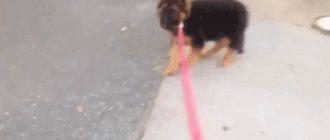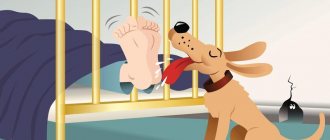Having decided to purchase a four-legged friend, every owner is aware that he is taking on a burden of responsibility and responsibilities. These include daily walks with your pet. But sometimes a walk becomes impossible due to the fact that the animal is simply afraid to leave the room. With what it can be connected? How to help a dog overcome fear? What are the main features of this problem? We will try to answer all questions.
The dog is afraid to walk outside, what should I do?
Why is a walk so important?
It would seem that the animal is afraid of the street, then why torture both the dog and the owner with daily walks? In fact, the street is not only a way for the animal to fulfill its physiological needs in the form of bowel movements and urination. Walking has many benefits.
Even as a small puppy, a dog learns to explore the world. Receives information about what is cold, hot, tasty, hard, soft, and so on. The dog interacts with other animals, insects, people. She learns to be in society, which means she becomes socially developed. Such dogs get used to their environment and strengthen their nervous system.
In addition, daily walks have a beneficial effect on the body. Fresh air, physical activity in the form of running, and receiving a different range of emotions allow the animal to prolong its life, which cannot be achieved in an apartment or house.
Through a walk, the puppy learns about the world around him
Useful video
To learn what to do if your dog is afraid of everything, watch this video:
Similar articles
- Why does a dog whine: does it for no reason, at night, during...
Out of fear, such dogs can hide in a corner, seek refuge under the sofa and in other hard-to-reach places. Read more - How to train a dog to wear a leash, walk with a collar...
When the dog gets used to walking on a long, loosely hanging leash and is no longer afraid of it, the length can be shortened. Read more
- How to train a dog to sit, to use the toilet, to sleep on your...
Competent recommendations on how to accustom a dog to a place (team, territory needed, sleeping). .serp-item__passage{color:#888}... Only after this can you play and walk with the dog. Read more
- A dog has pus from the nose: symptoms of sinusitis, how to treat...
Breathing is noisy. Lethargic state, the dog sleeps a lot, is reluctant to go for walks, refuses active games. Read more
- How to train a dog to a kennel: do it after the apartment...
It is best to take a leisurely walk with your pet near his shelter before doing this. At first, you can’t leave your dog alone on a chain for a long time. Read more
What dogs need to be walked?
Any animal needs daily walks, regardless of breed and size. Of course, small breed dogs such as Chihuahuas, Yorkies, Spitz dogs and so on can easily relieve themselves at home, in a specially designated place. Therefore, for such breeds there is no need for daily walking.
However, visiting the street is mandatory to get fresh air, new emotions and contacts with other representatives of flora and fauna.
As for large breed dogs, walking is simply a must. Otherwise, the animal will not only forget about the need to relieve itself on the street, but may simply begin to lose its mind within its four walls, since there will be no opportunity to give vent to emotions and splash out energy.
Every dog needs daily walks
Aggressive response to fear
Impulsive natures, choleric people, sanguine people do not run away when a feeling of fear appears. On the contrary, they immediately rush to an object that evokes negative emotions. If a dog not only barks at strangers, but also uses its teeth, it will not be possible to cope with such a pathology without a dog handler. Professionals know how to correct the behavior of such dogs.
If the pet barks, growls, but does not take active actions, you need to calmly and confidently approach him, take him by the collar and lightly pull him, give the command “quiet”. If this measure does not have the desired effect, you should squeeze the dog’s sternum with your knees and hold it until the object that caused the dog’s aggression leaves. Then you need to sit him down, sternly but calmly say “ok”.
You cannot pet or praise your pet when it is aggressive. If such inappropriate behavior appears, it is necessary to begin intensive socialization. Regular walks will be an important point. Gradually, you need to change walking areas from deserted ones to areas with active traffic, so that the dog gets used to it and understands that strangers do not pose a danger to it. A prerequisite is a friendly attitude towards the pet, calm, confident behavior in all situations.
Reasons why dogs are afraid of the street
Adults
Every conscientious owner considers it his duty to identify the reason for the animal’s fear of the outside world. However, breeders and dog breeders note that there are several classic reasons that result from a pet’s fear of the street. Let's get acquainted with the most common of them.
- The dog received bad memories and negative emotions . An animal's fear is a trigger that is very difficult to turn off. Perhaps the animal was frightened by the noise of traffic, unsuccessful contact with other representatives of the animal world, or was involved in an accident.
- Climatic features. Some animals run outside despite rain, hail, cold and severe frost. However, if the walk is being carried out for the first time, then bad weather can be a significant reason for further reluctance to continue walking. This is especially true for short-haired or hairless dogs. Afghan hounds are very susceptible to temperature changes.
Bad weather can make your dog reluctant to continue walking.
- The animal has poor hearing or vision . Very often, a dog suffers from retinal dystrophy. Because of this, they practically stop seeing in the dark, and even during the day their vision leaves much to be desired. During daylight hours, the dog can behave relatively adequately and not be too reluctant to go for a walk. In the evening, especially in winter, the animal begins to stupor and panic. The same goes for poor hearing. The animal sees a huge number of movable objects, but at the same time does not hear the sounds they make. This makes the dog feel uncomfortable.
- Chronic diseases . Some diseases prevent the dog from exercising for a long time. This applies to animals whose age has crossed the mark of 8-10 years. Almost every second pet has progressive arthritis. It causes pain and affects the nervous system. The dog feels weak and defenseless.
- Rabies and so on . All diseases that are associated with the nervous system entail a pathological fear of something new, communication with new people, objects, and other animals. As soon as the dog finds itself in an uncomfortable environment, where there are other sounds and smells to which it is not accustomed, a panic attack begins, after which the animal may behave inappropriately. If you can correctly establish the reason that became the basis for the animal’s fear, it will be much easier for you to overcome the problems.
Video - How not to develop fears and help your dog overcome them
Fear of the street in puppies
Puppies themselves are fragile and shy creatures. Fighting kids are rare among them. As soon as they find themselves in new conditions, they hide in a corner and get used to the situation.
Remember, when you first brought the dog to your home, it sat in a secluded place for a long time, and only after a couple of days, realizing that nothing threatened it here, it began to roam freely around the room.
The same thing happens with the street. The first walks with a puppy, who were taken away from their mother too early, are especially difficult; they feel defenseless.
Important! You should not take a walk on the same day or the next day after the animal ended up in your house or apartment. Let the dog get used to new conditions, make friends with everyone in the household. And only then get acquainted with the street.
Puppies need care and protection. Therefore, the owner should always be nearby, encouraging with words, or better yet, cajoling with various dog treats. This way the dog will get used to the fact that there is nothing scary on the street and will love your walks together.
The puppy needs to be constantly encouraged while walking.
When choosing places to walk with your puppy, give preference to places that are far from roadways and where there are no large crowds of people and animals. As soon as the animal gets used to the new conditions, you can make forays into places that are filled with life.
Psychological problems of shelter dogs
If you decide to do a good deed and share your home with a shelter dog, you may face a number of problems. Basically, animals that are abandoned at the shelter are abandoned animals, dogs that were born on the street in terrible conditions, lost animals or abandoned by their owners.
These are special animals that have received not only physical, but also moral trauma, which they still have not dealt with. Such a dog has experienced a huge amount of stress, and, possibly, physical impact, which has left its deep imprint.
A shelter is also not the best place for an animal to live. This is a real prison. If the shelter is not private, but public, then the animal is kept there with minimal funding, and only volunteers help them. The dogs that live in the shelter are mostly kept in cages and do not know what walks, games, or the love of their owner are.
Fear of the street may be due to the dog's reluctance to leave a quiet and secluded place
If you have sheltered such a prisoner, you may be faced with a fear of leaving your familiar premises. Very often, owners of such dogs make the mistake of almost forcibly dragging the animal out into the street. Under no circumstances should this be done. You risk causing the animal to become stupefied and panicked. It’s better to do everything gradually, using special methods for teaching dogs to walk. Only your patience, kindness, love, and the right approach can create a real miracle.
Fear of evening walks
As mentioned above, fear of the time of day can only manifest itself at one specific time, for example, in the evenings. Many people work late, and the opportunity to walk the dog only appears when dusk has already fallen on the city. It is at this time that the animal begins to really panic.
Be sure to make sure that the animal’s organs of vision and hearing are not damaged. And if the dog is healthy, then it is necessary to look for the reasons in the psychology of the animal. Phobias may include bright headlights that once blinded your pet while walking.
If you are the owner of small-breed animals, then you will be able to observe that in the dark the dog is afraid even of the rustling of garbage and panics. The fact is that dogs see poorly in the dark, and any extraneous sound seems to them like a hidden threat. The animal is in a state of constant stress throughout the entire walk, and it is quite understandable that next time the dog will not want to go for a walk with you on its own.
Fear of evening walks may arise due to illness in the dog
How to overcome fear
First of all, it is necessary to check the physical condition of the animal. If you are not a frequent visitor to a veterinary clinic, then it is worth going there and doing a comprehensive examination, giving preference to examining the organs of vision and hearing, taking tests from the animal, and checking for the presence of mental illnesses and abnormalities. Perhaps the animal is worried about something, and the fear of the street is simply a reluctance to increase the pain. If your animal is healthy, then you need to fight the phobia using other methods. If not, be sure to undergo a course of treatment before trying to instill in your dog a desire for a walk.
Animals feel good only when they feel safe when drinking water and eating. Guided by this principle, you can overcome your fear of changing territory. We offer you a few simple steps to help you fight your pet's fear of going outside.
- First of all, the owner must analyze his relationship with the dog. Perhaps you often raise your voice, make loud noises, yell at the animal, or even hit it. It is unacceptable. Try to control yourself for a couple of weeks, communicate with the animal in a kind and gentle voice, and do not shout for offenses, but reprimand them in a calm tone.
- Once trust has been established, try hand feeding the dog. Do this first near where the dog eats, right above the bowl. Don’t be disdainful, start with small portions, then increase the process until full feeding.
- Then, gradually move the eating area to the front door.
- Get your dog used to the collar. To do this, you periodically need to invite her to the front door, put a collar on her, attach a leash, at the same time, encourage her and treat her with goodies. The main goal of your actions is to leave in the animal’s memory positive moments about getting ready for a walk.
- Then start feeding on the landing. If possible, move further towards the entrance. The main thing is that someone does not scare the animal away, especially at first.
- Once you have reached the front door during the feeding process, you can take the decisive step. Be sure to bring your pet's food bowl with you. Choose a time so that there are as few people and other animals outside as possible. For example, early morning. Take a short walk for 10-15 minutes.
- Go, talk to the animal all the time, encourage it. It is important that your pet hears your voice and feels your presence nearby.
- After this, place the bowl on the ground and offer the dog to eat. However, take a look around the place. While eating, your animal should not be disturbed by strangers, cars, or other animals.
Recommendations from animal psychologists
Even if the first attempt is not successful, do not be discouraged. The dog has already gone outside, taken all the steps, which means success is just around the corner. After the dog has begun to eat freely on the street, and even after a while begins to beg for food from you on a walk, you can begin the most important stage, namely, socialization. Play with the animal, introduce it to other animals and people. Visit more and more new places. Gradually, the pet will get used to the new conditions, and even begin to enjoy what is happening.
How to help a dog
The most effective way to help dogs who are afraid to go outside feel more confident outside is to change their relationship with the outdoors through a combination of desensitization and resistance training.
© shutterstock
The first step is desensitization training, which allows the dog to experience the feared stimulus at a non-stressful level. For example, a dog that is nervous about running into garbage trucks might encounter a truck that is parked and silent, several blocks away so that it can see it, but is far enough away from it that it does not react to it.
Counterconditioning, which works in tandem with desensitization, helps the dog form a new association with the stressor through positive associations. With the garbage truck positioned at a distance, feed your dog a series of high-value treats when he spots the truck, such as pieces of cheese or sausage, so that your dog begins to make the connection between the scary garbage truck and the wonderful treats. Then gradually reduce the distance between your dog and the garbage truck, always rewarding him with treats for his calm response. Over time, your dog will be able to walk past garbage trucks without fear.
Using a training process called shaping can help dogs who are afraid to go into their own yard. This type of training breaks down the walking process into manageable parts and rewards the dog for successfully navigating each part.
Pet parents can start the process by standing right outside the door with a handful of treats. When your dog steps toward the door, mark his behavior with a click of the clicker or a verbal marker, such as “okay!” then throw the treat to your dog where he is standing. Do not force your dog to come to you for a treat or try to lure him to you with a treat. Let him move on at his own pace, celebrating and rewarding each step of the process until he crosses the threshold.
Keep in mind that any dog that is suddenly afraid to go outside or into the yard may need to undergo a medical examination. Ensuring your dog's physical well-being and taking steps to train him to improve his confidence can help make timeless fun for both ends of the leash.
Collar and leash
Very often, an animal’s fear of going for a walk arises because the owner has chosen the wrong collar or leash. Perhaps the collar rubs the animal’s skin, hugs the neck too tightly, or has elements that scratch the skin. An incorrectly selected leash is also a whole problem. It may be too heavy, knock too much, distracting the animal, or you may be pulling it too hard and thereby creating discomfort for the dog when walking.
Therefore, if even after eating the dog refuses the leash and collar, or allows you to do this without much desire, be sure to make sure that you have chosen the right accessories.
An incorrectly selected collar or leash can make your dog reluctant to leave the house.
Why does a dog relieve itself at home?
Reluctance to go for a walk can be accompanied by unpleasant situations. After experiencing severe stress, a pet accustomed to walking can relieve itself at home.
Disorders of the urinary system may also be involved in the reasons for relieving yourself at home. To rule out diseases, you need to visit a veterinarian and undergo a medical diagnostic test.
It is important that your pet should not be scolded for making a puddle at home, even if there were no problems with it before. If the problem is stress or illness, the psychological state of the pet will only worsen.
Games
Young dogs love to play. Immediately after eating, they carry their owner’s favorite toy, joyfully twirl their tail, wiggle their ears, breathe continuously, waiting to receive attention and play. Use your dog's desire to be physically active and play in the right way.
Offer your animal outdoor activity. Perhaps the dog feels uncomfortable in such conditions, however, when he sees his favorite toy that you took out of your pocket, he immediately begins to understand that there are no threats and fun lies ahead.
At first the game will take place timidly, but after some time the animal will forget that it is on the street. Games should be active, fun, and involve a lot of running. This is necessary so that the dog is constantly in a state of movement and is not distracted by what is happening around it.
Outdoor games will help your dog overcome his fear of the street
Rules for the owner
Your reaction to certain actions of the animal can also be of no small importance. Unfortunately, many owners independently discourage the animal from wanting to go for a walk. Be sure to familiarize yourself with the basic rules of walking so as not to aggravate the situation.
- If, when you first go outside, the animal is in a state of panic, tries to hide behind you or pulls you towards the entrance, you should not pet the dog, caress it, or try to pick it up. The animal may understand these signals as your approval, and will ask to go home even more.
- Try to constantly distract the animal from what is happening around. Do not be silent. Don’t stand still expecting your pet to start running around the lawn and enjoying life. Offer your dog treats and entice him with games. If the animal still makes attempts to move independently, be sure to praise the dog and support it.
- Under no circumstances should you be nervous, shout at the animal, or even lay your hand on it. For a dog, you are the leader of the pack; you are always calm, wise and reasonable. The whole situation is always under your control. This behavior will show the animal that there is no danger around, which means there is no reason to worry.
- You should not teach or repeat commands with the animal if the dog is very nervous. You are getting used to the street, not preparing for a competition. Therefore, be patient and persistent. You will begin to repeat and learn commands when the dog happily asks to leave the apartment.
How long should you walk your dog?
Accustoming an animal to the street does not take place in one day. This is a very complex, time-consuming and psychologically important process. However, if you overcome all difficulties together, you will become even closer to your pet and increase the level of trust. The animal will know that where you are, it is always calm, good and warm. Take care of your four-legged friend, create all conditions for his comfort. You will truly enjoy your daily walks.
Common Mistakes
Walking puppies that are too young and have not undergone the first vaccination can lead to infection and even death if they come into contact with other dogs. Such babies can only be walked in your arms.
Attempts to calm a puppy showing signs of panic (plaintive whining, tucking its tail, trying to retreat into the bushes, trembling all over the body). Soothing stroking and coaxing will be perceived by the puppy as praise for this behavior. To prevent a repetition of the situation, you need to fraudulently lead your pet to the object that frightened it and convince it of its safety. If the puppy obeys and behaves calmly, you should praise him and give him a treat.
The most correct tactic for accustoming a puppy to the street should be the tactic of a reasonable compromise. You can’t constantly take him out into the street, full of strong irritants, but it’s equally wrong to protect him too much from city noise.
Excessive haste , attempts to forcibly drag the puppy onto the street that frightens him. This behavior of the owner can only provoke aggression in the pet for the purpose of self-defense.
Incorrectly built hierarchy in the relationship between owner and pet. A puppy whose every whim is immediately fulfilled may decide that he is allowed to manipulate his owner.











